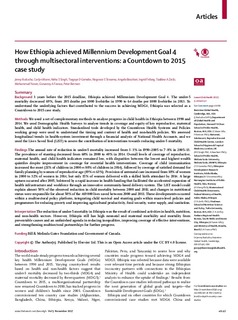| dc.description.abstract | Background 3 years before the 2015 deadline, Ethiopia achieved Millennium Development Goal 4. The under-5 mortality decreased 69%, from 205 deaths per 1000 livebirths in 1990 to 64 deaths per 1000 livebirths in 2013. To understand the underlying factors that contributed to the success in achieving MDG4, Ethiopia was selected as a Countdown to 2015 case study. Methods We used a set of complementary methods to analyse progress in child health in Ethiopia between 1990 and 2014. We used Demographic Health Surveys to analyse trends in coverage and equity of key reproductive, maternal health, and child health indicators. Standardised tools developed by the Countdown Health Systems and Policies working group were used to understand the timing and content of health and non-health policies. We assessed longitudinal trends in health-system investment through a financial analysis of National Health Accounts, and we used the Lives Saved Tool (LiST) to assess the contribution of interventions towards reducing under-5 mortality. Findings The annual rate of reduction in under-5 mortality increased from 3.3% in 1990-2005 to 7.8% in 2005-13. The prevalence of stunting decreased from 60% in 2000 to 40% in 2014. Overall levels of coverage of reproductive, maternal health, and child health indicators remained low, with disparities between the lowest and highest wealth quintiles despite improvement in coverage for essential health interventions. Coverage of child immunisation increased the most (21% of children in 2000 vs 80% of children in 2014), followed by coverage of satisfied demand for family planning by women of reproductive age (19%vs63%). Provision of antenatal care increased from 10% of women in 2000 to 32% of women in 2014, but only 15% of women delivered with a skilled birth attendant by 2014. A large upturn occurred after 2005, bolstered by a rapid increase in health funding that facilitated the accelerated expansion of health infrastructure and workforce through an innovative community-based delivery system. The LiST model could explain almost 50% of the observed reduction in child mortality between 2000 and 2011; and changes in nutritional status were responsible for about 50% of the 469 000 lives saved between 2000 and 2011. These developments occurred within a multisectoral policy platform, integrating child survival and stunting goals within macro-level policies and programmes for reducing poverty and improving agricultural productivity, food security, water supply, and sanitation. Interpretation The reduction of under-5 mortality in Ethiopia was the result of combined activities in health, nutrition, and non-health sectors. However, Ethiopia still has high neonatal and maternal morbidity and mortality from preventable causes and an unfinished agenda in reducing inequalities, improving coverage of effective interventions, and strengthening multisectoral partnerships for further progress. Copyright (C) The Author(s). Published by Elsevier Ltd. | |
